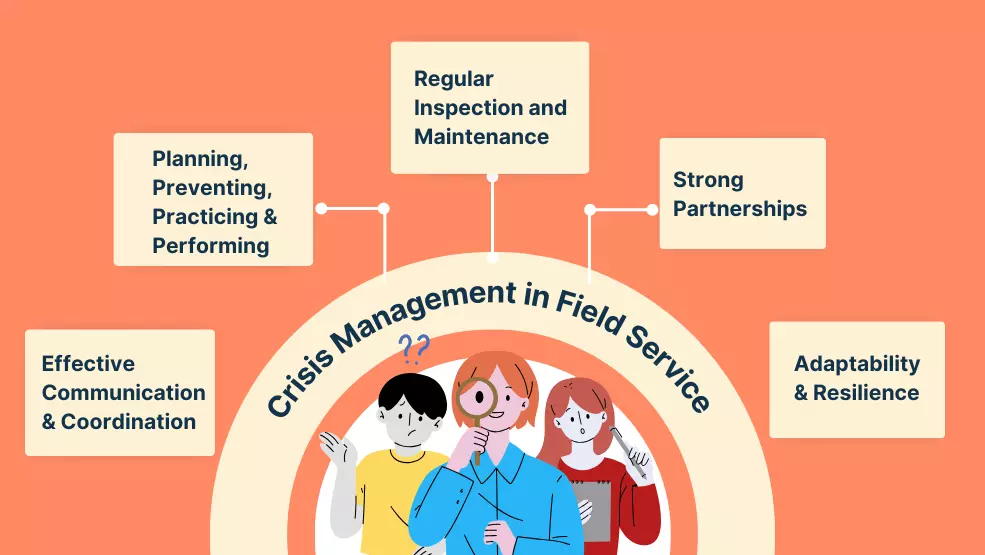Field service crisis management is more than just a checkbox in business continuity planning—it is the linchpin that can shape a company’s reputation, impact customer satisfaction, and boost financial performance. Unexpected events, such as natural disasters, technological outages, or economic crises, can disrupt field service operations and pose significant challenges to businesses. On that note, let’s explore some real-world examples that sent shockwaves across the globe and learn how to grow your business even during periods of unpredictability.

1. Effective communication and coordination
On July 19, 1989, United Airlines Flight 232 suffered an engine failure shortly after takeoff from Denver, Colorado. The DC-10 aircraft lost all hydraulic power, rendering its flight controls inoperable. Despite the perilous situation, the crew managed to land the plane safely at Sioux City Airport, saving the lives of all 296 people on board.
The successful landing of United Airlines Flight 232 exemplifies the importance of clear communication and coordination during a crisis. Despite the dire situation, the crew maintained composure and effectively communicated with air traffic control and other response teams, ensuring a coordinated and successful outcome.
2. Planning and preparedness
On April 20, 2010, the Deepwater Horizon oil rig exploded in the Gulf of Mexico, causing the largest marine oil spill in history. The disaster released over 200 million gallons of oil into the Gulf, causing widespread environmental damage and economic hardship. The response to the spill was hampered by a lack of coordination and communication among various agencies, demonstrating the importance of effective crisis management planning and collaboration.
3. Strong partnership
In October 2012, Hurricane Sandy wreaked havoc on the East Coast of the United States, causing widespread power outages, flooding, and infrastructure damage. The storm caused an estimated $65 billion in economic losses and resulted in the deaths of 182 people. The response to Hurricane Sandy was marked by strong cooperation between government agencies, non-profit organizations, and the private sector.
Not only government bodies but also private sectors like Walmart, Verizon, and JPMorgan Chase volunteered to help people by donating food, water, and money. This demonstrates the value of partnerships in crisis management. The lesson learned here is to expand your partner ecosystem and provide more integration to your customers.
4. Regular inspection and maintenance
On April 17, 2013, Southwest Airlines Flight 1380 suffered a catastrophic engine failure shortly after takeoff from LaGuardia Airport in New York City. The Boeing 737-700 aircraft lost a portion of its fuselage and engine, causing rapid depressurization and severe damage to the aircraft. The crew managed to land the plane safely at Philadelphia International Airport, saving the lives of all 115 people on board.
This incident highlighted the importance of regular maintenance and inspections, as well as the ability of flight crews to respond quickly and effectively in emergency situations. The lesson learned here for field service organizations is you should prioritize regular maintenance schedules, thorough inspections, and timely replacement of aging components.
5. Adaptability and resilience
The COVID-19 pandemic, which began in 2020, has posed an unprecedented challenge to field service organizations worldwide. The pandemic has caused widespread disruptions to supply chains, labor markets, and customer demand, forcing field service companies to adapt their operations to ensure the safety of their employees and the continued delivery of essential services. The pandemic has also highlighted the importance of crisis management planning, communication, and collaboration in addressing large-scale disruptions.
The COVID-19 pandemic has tested the adaptability and resilience of field service organizations. The ability to adapt operations to changing safety protocols, maintain communication with customers, and implement remote solutions has been crucial for continued service delivery and business survival.
Types of crisis management
Understanding the different types of crises can help organizations better prepare for and respond to potential threats.
1. Natural disasters
These crises are caused by natural phenomena such as hurricanes, earthquakes, floods, wildfires, and tornadoes. They can cause widespread damage to property, infrastructure, and the environment and can also lead to loss of life.
2. Technological crises
These crises arise from failures or malfunctions of technological systems, including computer systems, power grids, and transportation networks. They can disrupt essential services, cause economic losses, and even threaten public safety.
3. Human-caused crises
These crises are intentionally or unintentionally caused by human actions, such as accidents, terrorism, industrial disasters, and wars. They can result in significant loss of life, environmental damage, and economic hardship.
4. Organizational crises
These crises are specific to organizations and can be caused by internal or external factors. Examples include financial crises, product recalls, data breaches, and reputational damage.
5. Situational crises
These crises are triggered by personal or immediate situations, such as a car accident, a medical emergency, or a criminal act. They can cause emotional distress, physical harm, and financial strain.
6. Confrontation crises
These crises involve conflict or opposition between individuals or groups, such as labor disputes, protests, and legal battles. They can disrupt operations, damage reputations, and escalate into violence.
7. Crisis of malevolence
These crises are intentionally caused by individuals or groups with malicious intent, such as cyberattacks, acts of terrorism, and targeted violence. They can cause widespread disruption, fear, and loss of life.
8. Crisis of organizational misdeeds
These crises arise from unethical or illegal behavior within organizations, such as fraud, corruption, and environmental violations. They can damage reputations, erode public trust, and lead to legal and financial consequences.
9. Crisis of mismanagement
These crises are caused by poor leadership, decision-making failures, and a lack of crisis preparedness within organizations. They can lead to financial losses, operational disruptions, and damage to stakeholder relationships.
10. Crisis of communication failures
These crises arise from ineffective or inadequate communication during a crisis situation. They can lead to confusion, misinformation, and a loss of trust among stakeholders.
Field service crisis management plan
Your crisis management plan for field service should have a clear focus centering on stablizing communication, logistics, and resource deployment. Having a crisis management team would be great. Here is the crisis management plan.
1. Set a clear purpose
The purpose of this crisis management plan is to provide a framework for the field service company to effectively prepare for, respond to, and recover from crises. The plan outlines the roles and responsibilities of different departments and personnel, as well as procedures for communication, resource deployment, and progress tracking.
2. Have a crisis management team
The crisis management plan will be activated when a crisis is identified or suspected. The activation decision will be made by the crisis management team, which will be composed of representatives from the following departments:
- Operations
- Customer service
- Human resources
- Public relations
- Legal
3. Assign roles and responsibilities to your team
The crisis management team will be responsible for overseeing the crisis response and ensuring that all resources are effectively deployed. Specific roles and responsibilities include:
- Crisis manager: Leads the crisis management team and oversees all aspects of the crisis response.
- Communications lead: Handles all crisis communications, including media relations, customer updates, and employee notifications.
- Logistics lead: Manages the deployment of field service technicians and equipment to the scene of the crisis.
- Operations Lead: Coordinates with customers to assess damage and prioritize service calls.
- Human resources lead: Provides support to employees affected by the crisis, including counseling and assistance with insurance claims.
- Legal counsel: Provides legal advice and representation to protect the company’s interests.
4. Design a communication strategy
The crisis communication plan outlines the procedures for communicating with customers, employees, and the media during a crisis. Key elements of the plan include:
- Identifying spokespersons: Designate specific individuals to speak on behalf of the company during the crisis.
- Establishing a media relations process: Develop procedures for handling media inquiries and issuing press releases.
- Creating customer notification protocols: Establish protocols for notifying customers about the crisis and keeping them updated on the situation.
- Utilizing internal communication channels: Use internal communication channels to keep employees informed and engaged.
5. Have a clear resource deployment plan
The resource deployment plan outlines the procedures for dispatching field service technicians and equipment to the scene of a crisis. Key elements of the plan include:
- Identifying priority areas: Determine the areas that are most heavily impacted by the crisis and prioritize resource deployment accordingly.
- Assessing technician availability: Assess the availability of field service technicians and their proximity to the affected areas.
- Coordinating with logistics: Coordinate with the logistics team to arrange transportation and equipment for deployed technicians.
- Tracking resource deployment: Track the location and status of deployed resources to ensure effective coordination.
6. Track the progress tracking plan effectively
The progress tracking plan outlines the procedures for tracking the progress of the crisis response. Key elements of the plan include:
- Establishing key performance indicators (KPIs): Define KPIs to measure the effectiveness of the crisis response, such as the number of service calls completed, the number of customers satisfied, and the time to restore full operations.
- Monitoring KPIs: Regularly monitor KPIs to assess progress and identify areas for improvement.
- Reporting on progress: Prepare regular reports on progress for the crisis management team and stakeholders.
7. Review and update your plan annually
The crisis management plan will be reviewed and updated annually or more frequently as needed to reflect changes in the company’s operations, risks, and legal landscape.
8. Give training to your workforce
All employees will be trained on the crisis management plan and their roles and responsibilities in the event of a crisis. Training will be conducted regularly and will include tabletop exercises to test the plan and identify areas for improvement.
Build a crisis-ready business model!
The four ‘P’s of crisis management are prevent, plan, practice, and perform. And the five incidents we discussed provide valuable lessons for field service organizations on how to effectively prepare and perform during a crisis. Just remember that the strong pillars during a crisis are adaptability, resilience, and communication, by which your business not only survives but emerges stronger.
Step up and be a force for good. For every T-shirt you wear, over 700 gallons of water is consumed. You hold the power to reclaim gallons of water with every garment you wear. Choose minimalism; Save water. Mindful closet for a sustainable future!



